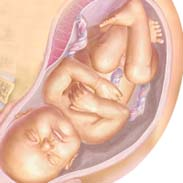Pregnancy and Rheumatic Diseases
Michael Lockshin
 |
A 39-year-old woman with long-standing rheumatoid arthritis, which she believes is now quiescent, consults you because she is planning a pregnancy. She has not been under regular medical care, but instead has taken ibuprofen or naproxen on an as-needed basis for joint pain. A prior pregnancy 3 years earlier was successfully delivered at term. She comes now at the insistence of her colleague. She asks for your advice regarding risks to her and her potential child, particularly those imparted by treatment. You point out that anti-inflammatory medications interfere with cilial motion that transports the ovum through the Fallopian tube and, thus, modestly inhibits fertility.
Your evaluation shows moderately active synovitis in her wrists (with signs of early carpal tunnel syndrome), elbows, and knees. Her laboratory studies show strong positive rheumatoid factor, anticyclic citrullinated peptide, and anti-Sjogren’s syndrome A (SSA), also known as anti-Ro. Anti-Sjogren’s syndrome B (SSB) antibodies, also known as anti-La, anticardiolipin, anti-β2-glycoprotein I, and lupus anticoagulant tests are negative. Lateral cervical spine x-ray in flexion and extension shows 11-mm displacement of the odontoid process from the anterior arch of the atlas in flexion.
Clinical Presentation
That the patient has not been in medical contact despite ongoing disease is a matter of concern. Her choice may reflect misunderstanding about her illness, conflicts with her physicians, social or financial issues, denial, or other issues. Whatever the reason, her earlier choice to avoid medical care raises flags for management of a future pregnancy.
Examination
Immediate things to assess include careful joint examination, focusing especially on joint instability, because of potential worsening as pregnancy-associated relaxin loosens ligaments in late pregnancy. Cervical spine subluxation and C1 to C2 instability are especially important because of potential cord injury. It may be necessary to provide the patient with a rigid collar during late pregnancy and during delivery, when intubation is a possibility. Ligament loosening at the hip and knee may cause gait problems as pregnancy progresses. Carpal tunnel symptoms typically worsen in late pregnancy.
Studies and Treatment
Infants of mothers with anti-SSA and anti-SSB antibodies are at risk for neonatal lupus (rash, about 20%; congenital heart block, about 3%) (1). Pregnancies characterized by these autoantibodies require special monitoring of fetal cardiac status (by fetal echocardiogram looking for ventricular contraction strength, pericarditis, and atrial–ventricular conduction delay) between weeks 15 and 26 (2).
However, effective treatment for in utero heart block is not available (3); early delivery may be required. Neonatal lupus rash, if it occurs, will appear after delivery. Hydroxychloroquine may be protective (4).
However, effective treatment for in utero heart block is not available (3); early delivery may be required. Neonatal lupus rash, if it occurs, will appear after delivery. Hydroxychloroquine may be protective (4).
Patients with any rheumatic illness may have antiphospholipid antibodies. Low-titer antiphospholipid antibodies do not appear to impart risk and need not be treated; lupus anticoagulant and possibly high-titer IgG anticardiolipin may lead to early, severe preeclampsia, premature delivery, and fetal growth restriction or death (5). For this patient, the negative tests and the prior successful pregnancy are reassuring that she is not at risk. Evidence is unclear whether pregnant patients with lupus anticoagulant who have not had a prior thrombosis or fetal loss should be prophylactically treated with heparin (prophylactic doses, usually 1 mg/kg enoxaparin per day or its equivalent). Evidence is weak that it is necessary to treat patients who have anticardiolipin antibody without lupus anticoagulant, but not prior thrombosis or fetal loss. Patients with prior fetal losses and high-titer anticardiolipin or lupus anticoagulant but no prior thromboses should receive prophylactic dose treatment; those with prior thromboses should receive therapeutic dose treatment (1 mg/kg enoxaparin every 12 hours or its equivalent).
Clinical Points
Anti-inflammatory agents inhibit fertility.
Stay updated, free articles. Join our Telegram channel

Full access? Get Clinical Tree








